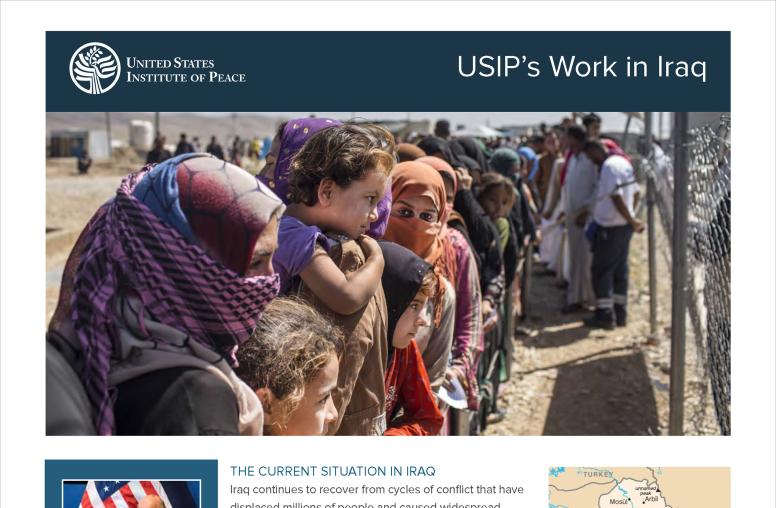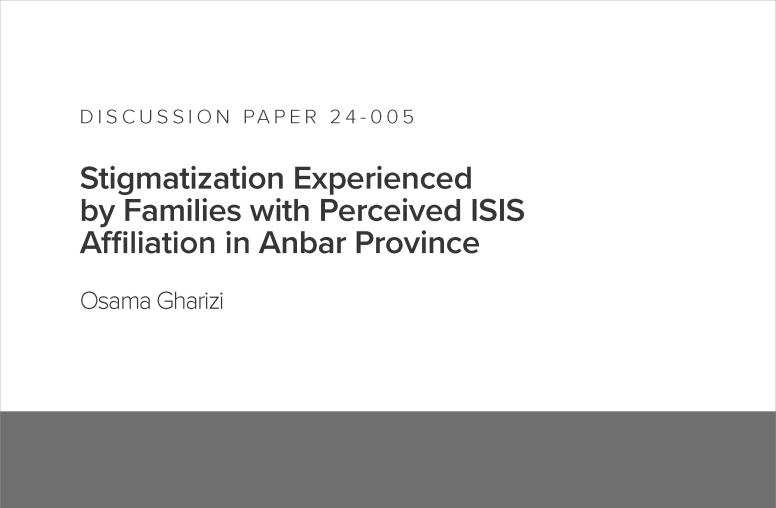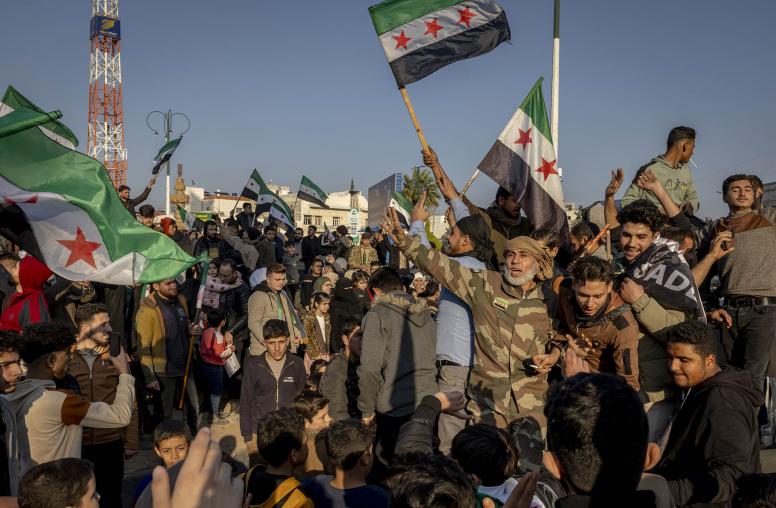New Talks Could Help Iraq Find Room to Stabilize Amid Crises
Diplomacy could offer breathing space for a government pinned between Iran and the United States.
As Iraq’s government struggles to build stability in the face of economic decline, COVID, political protest and periodic violence, it may see new hope for some maneuvering room in its narrow political space between the United States and Iran. One day after U.S. and Iranian officials agreed through intermediaries to work toward restoring the 2015 accord over Iran’s nuclear program, American and Iraqi diplomats announced an intent to remove U.S. combat forces from Iraq. Both initiatives face deep uncertainties. But if successful they could widen Iraq’s difficult path toward peace.

Iraq and the United States said yesterday’s talks in the countries’ “strategic dialogue” affirmed progress in making Iraq’s security forces capable of preventing a resurgence of the Islamic State group (ISIS) extremist threat. That progress can allow “the redeployment of any remaining [U.S] combat forces from Iraq, with the timing to be established in upcoming technical talks,” the governments said. The United States says it has 2,500 U.S. troops in Iraq.
Iraq and the NATO alliance announced in February that NATO will expand its non-combat training mission from 500 troops to about 4,000 to further strengthen Iraq against an ISIS revival. Iraqi Prime Minister Mustafa al-Kadhimi has touted to Iraqis a drawdown of U.S. combat forces and their eventual departure — a demand reiterated last week by Iraqi political and armed groups aligned with Iran.
A replacement of U.S. troops by NATO trainers will lower the American profile in Iraq but is not likely to end domestic pressures for a removal of all foreign forces, noted Sarhang Hamasaeed, who directs Middle East programs at USIP. “Iran and its Iraqi allies are skeptical of a NATO role in Iraq because they think a force of that size would get in the way of their agenda and could be quickly turned into a combat mission that could threaten them,” said Hamasaeed. “Also, it runs counter to their objective of getting foreign troops out of Iraq.”
Iraq: Pinned Between U.S., Iran
Yesterday’s announcement from U.S.-Iraqi talks came just 24 hours after the United States and Iran agreed to work, through other members of the 2015 accord on Iran’s nuclear program, to restore both countries’ compliance with that pact. U.S.-Iranian hostility sharpened after President Donald Trump withdrew the United States from that accord in 2018, imposing a web of economic sanctions that — along with declining oil prices — have throttled Iran’s economy, forcing its shrinkage over the past three years.
No country has been more at risk from that renewed U.S.-Iranian hostility than Iraq. Effectively, that confrontation has held Iraq in a kind of political straitjacket as it has struggled to solve its own problems. “Iraq cannot make binary choices between Iran and the U.S., because there will be serious consequences either way,” said Hamasaeed.
Amid Iraq’s communal divisions — most notably among its Arab Sunni, Arab Shia and ethnic Kurdish populations — Iran has long influenced Iraqi politics through its support for numerous Shia organizations, four of which combined in 2018 elections as the Fatah Alliance, winning 15 percent of seats to become the second-largest bloc among nearly a dozen major factions in parliament. Iran also wields influence through an array of armed groups, which expanded to more than an estimated 100,000 fighters to combat the ISIS takeover of much of Iraq. While such groups are nominally part of the state’s forces, many operate independently, effectively as Iranian proxies.
Prime Minister al-Kadhimi came to office 11 months ago amid an extreme version of the predicament facing all Iraqi governments since 2003 — trying to un-knot Iraq’s domestic crises while trapped in the hostility between Iran, the country’s biggest neighbor, and the United States, its most powerful foreign partner. Domestically, Kadhimi was a compromise candidate among Iraq’s 10 or so major factions in parliament as the state faced mass street protests against corruption, a lack of jobs and failings of governance.
Kadhimi took office as U.S.-Iranian hostility peaked following the missile strike ordered by President Trump that killed the top-ranking Iranian general, Qassem Soleimani in Baghdad. Also killed was the deputy commander of the Iraqi armed groups known as the Popular Mobilization Forces. Iranian proxy forces responded with a long string of missile attacks on Iraqi bases housing U.S. troops and Iraq’s parliament demanded the withdrawal of all foreign troops from the country.
The United States, fearing a possible attack by pro-Iran groups on the U.S. Embassy in Baghdad, threatened in September to pull out its diplomatic mission — and Kadhimi sent his foreign minister for talks in Iran that led to a reduction in tensions. An alliance of pro-Iranian groups offered to halt attacks on American targets if Kadhimi’s government would obtain a commitment and a schedule for the withdrawal of U.S. forces from the country.
Layers of Crises
Iraq faces a volatile 2021, with national elections planned amid layers of crises. One of the most urgent is an economy stifled by the COVID pandemic and the collapse of international prices for gas and oil, exports that fund 90 percent of the government’s revenue. The crisis is pushing millions of Iraqis into poverty and widening the unemployment that opens opportunity for extremist narratives and recruitment.
Iraq also is working to heal the raw wounds of communal conflict following the defeat of ISIS, which still has left communities shattered and displaced. Communities such as Tal Afar, Tikrit and others have made progress through local dialogues. Last month’s visit by Pope Francis to Iraq underscored hopes that reconciliation can include its minority communities and also the deep political and governance changes that will be required.
And Kadhimi’s government continues to try to assert greater control over some of the pro-Iranian armed groups, which last month underscored their continued readiness to challenge the government by driving a convoy of fighters brandishing weapons through Baghdad — and past government security forces — to denounce the U.S. presence in the country and warn Kadhimi against accommodating it.
U.S.-Iran Trajectory is Vital
Any reversal of those U.S.-Iranian tensions offers hope — but no guarantee — that Iraq’s government can pursue stabilization from conflict and violence. All sides in this week’s discussions on the nuclear deal described them as constructive — but also only a beginning in a long process that carries no guarantee of success. Russian Ambassador Mikhail Ulyanov, the Russian representative to those discussions in Vienna, was cautious in a statement via Twitter, saying that any restoration of the agreement “will take some time. How long? Nobody knows. The most important thing … is that practical work toward achieving this goal has started.”
“Even if the nuclear deal is restored, that can truly help Iraq only if it leads to less tensions between the U.S. and Iran on Iraqi soil,” said Hamasaeed. The nuclear pact in 2015 did not serve as a starting point for addressing Iran’s role within Iraq, notably through its armed proxies, or for reducing the related conflicts within Iraq, he noted. “The prospects of a better outcome now are slim, but not non-existent.”
A further complication is that a lifting of U.S. sanctions in any full restoration of the Iran nuclear deal “will free Iran to access more funds, giving it resources to actually increase its influence in countries like Iraq and Lebanon,” said Elie Abouaoun, who directs USIP work in the Middle East and North Africa. “It is essential that the negotiations happen in a way that prevents this.”
Helping Iraq find the political space and the resources to avert renewed extremism and war will not be a straight path. It will need to avoid pushing Iraq into the binary choices that Hamasaeed points out it cannot make. If these fragile first diplomatic steps of 2021 are to be cultivated to help Iraq stabilize, the effort will have to sustain a long timeline and a broad focus on Iraq’s many needs. Yesterday’s U.S.-Iraqi summation of the countries’ joint talks lists upcoming bilateral efforts on helping Iraq respond to COVID, improve education, restore its economy and build energy efficiency. That is the kind of breadth required, rather the narrow focus on hard security issues that so often dominate policy discussion.



